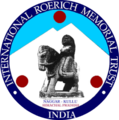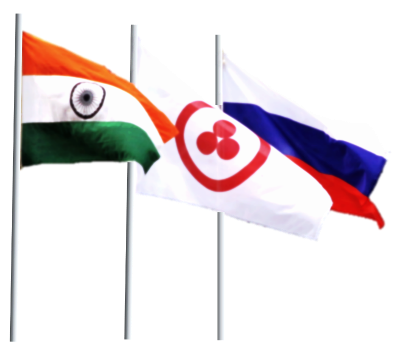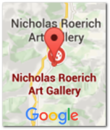06.06.2024
“Artistic Vision” in the Roerich Trust
Organised by Studio Seven, the exhibition was inaugurated by Mr Anuj Sharma, Deputy District Attorney of Kullu district, Mrs Larisa Surgina, the Russian Curator of the IRMT, Mr Suresh Kumar, her Indian counterpart, as well as Indian and Russian guests and staff of the Roerich Trust.
In his introductory remarks, Mr Sharma underscored the significance of showcasing such accomplished artists in a venue that was not a conventional art hub, such as Delhi or another major city. Instead, the exhibition was held in Naggar, a location associated with the Roerichs' estate. The artists' decision to hold the exhibition in Naggar was a conscious one. They believe that it is important to draw attention to the heritage of the Roerich family in India and to encourage the younger generation to engage with this heritage.
In her welcome address, Professor Vandana Verma, one of the participating artists, noted that several of her students were engaged in research on themes related to the work of Nicholas Roerich. She expressed hope that in the future they would be able to visit the Roerich Estate in Naggar to continue their work and contribute to the dissemination of Roerich's work in India. Dr. Rajneesh Gautam, a colleague of Prof. Verma, has indicated that this is not the first exhibition at IRMT in which the artists are participating. For them, Naggar is closely associated with the name of Nicholas Roerich, which is significant for contemporary Indian artists. As an artist and intellectual, Nicholas Roerich inspired and mentored a younger generation of Indian artists, participated in exhibitions, and contributed to the educational work of art schools. He also corresponded with numerous renowned painters. His writings on art, which were included in numerous anthologies and published in newspapers, became iconic for the Indian intelligentsia. Dr Rajneesh Gautam and his colleague, Professor Vandana Verma, continue the work of Nicholas Roerich. Seminars are held under their guidance, and collections of articles on art are published annually. They engage the younger generation of artists and art historians, namely their students, in their scientific endeavours.
The artists adopt disparate approaches to their craft, encompassing a spectrum of styles from impressionism to modernism and realism.
Suresh Kumar's works are figurative and constructed upon contrasts. They reflect intricate and profound relationships between man and woman, between generations, and between human nature and the divine.
Prasanth. A.V.'s abstract works reflect the vast expanse of human thoughts and feelings, the refraction of the divine through the prism of human thinking. They illustrate the interweaving of mysterious forms, encompassing both divine and human elements, as well as a kaleidoscope of colours and dimensions.
The contribution of colleagues in the field of education is of great significance. Art, as an integral aspect of culture, serves as a vital link in the formation of the cultural space of modernity. It is a pivotal driving force of cultural progress, without which it is impossible for countries and peoples to flourish. The preservation and study of Indian culture and Indian art, the continuation of cultural traditions and their rethinking in the context of modernity, represent a significant undertaking for artists and art workers. The team of authors whose works were presented at the exhibition is engaged in this endeavour with great dedication.
In Ushita Jain's paintings, the natural realm is depicted as being transferred to the spiritual plane. The turtles, to which a series of works by the author is dedicated, are depicted as being within the element of spirit, subject to laws other than those of the physical world. They glow, their movements and the patterns on their bodies are twisted in the rhythms of the universe around them.
Alphee Kumar's works are constructed around the concept of the sphere as the most ideal and complete form. The artist employs a variety of techniques, including the use of colour and structure, to convey a range of emotions and sensations, as well as different moods, through the same compositional approaches.
In the works of Himachal artist Urvashi Kanwar, simple objects such as cones of Himachal pine trees and mushrooms, which are found exclusively in the state, are used as a basis for composition. These objects are depicted in isolation from the environment, taken out of context. This technique enables the artist to appeal directly to the subconscious, thereby constructing the meaning of the paintings on the associative series that arise in the mind of the viewer.
On 6 June, the International Roerich Memorial Trust hosted the opening of an exhibition of 11 artists entitled "Artistic Vision".
Vivek Prabhukeluskar's works are filled with a cheerful harmony of colour and form. Little dancers with cute baby faces seem to be performing their dance in the centre of the universe, like Indian gods in their tandava dance. The curly-haired Ganesha boy plays in the middle of the ocean watching the mouse Mushaka who with a sly expression trying to carry away the modak, a sweet dumpling so favourite of Ganesha. And here is little Ganesha playing with Mushaka in the roots of the sacred pipal tree. The artist's works are touching and seem to transport the viewer to a kind universe full of beauty and childlike innocence.
The oeuvre of the artist's wife, Nilangee Prabhukeluskar, exhibits a markedly divergent stylistic approach. The works are symbolic and graphic in nature. The meaning of the works is conveyed through the composition, which is manifested in the simplicity and schematic form. The artist's creative intent is readily discernible. In front of us is a figure, which appears to be reflected in the image, and the two figures hold hands to form the shape of a circle. The dark, shaky surface from which the reflected figure emerges is in stark contrast to the clear sky with singing birds at the top of the painting, situated within the sphere of another figure. The painting's meaning can be interpreted as an indication that it is only through individual human effort that one can transcend the despair of existence and attain a state of joy and harmony. The artist's oeuvre is characterised by a laconic and clear expression of ideas in the language of images and bright colours.
Professor Vandana Verma's oeuvre is most closely aligned with the style of impressionism. The realistic images depicted in her paintings are executed in a colour scheme that reflects and conveys the artist's feelings and sensations. To illustrate, the painting depicting Devprayag Sangam, the confluence of the Alaknanda and Bhagirathi rivers that form the Ganga, is executed by the artist with a preponderance of yellow and blue hues. Similarly, the mood of the portraits of women is underscored by an intriguing interplay of colour and form.
Dr Rajneesh Gautam presented a series of abstract works, which were met with considerable interest by the audience. The artist is adept at working with a variety of techniques. Additionally, the exhibition features a realistic pencil sketch by the artist, created on the spot in just 15 minutes, as well as a series of graphic works.
The paintings of Beenu Gupta are executed in a subdued colour palette. The works appear to emanate a sense of the season of autumn. The works reflect the autumnal aspects of human life. As with the leaves on the trees, human life has a tendency to conclude with a decline before a subsequent rebirth. The artist's paintings can be described as poetic compositions in colour, celebrating the boundless beauty and harmony of life and nature, and the symbiotic relationship between humanity and the natural world.
Reena Choudhary's works presented at the exhibition reveal the theme of femininity: the female images in the paintings are full of sadness and hope, they look at the viewers from the prison of their everyday life with stubbornness and will to live. The paintings symbolically reflect both the darkest and the brightest moments of a woman's existence. The artist's paintings combine realism and symbolism with an impassioned use of colour combinations.
The excursion through the exhibition became for the audience a kind of immersion into such different and dissimilar creative realms that, despite their differences, converge at a common point where aesthetic appeal of the human spirit merges with the beauty of the higher reality that stands behind each image, skillfully expressed by the artists on their canvases.













































